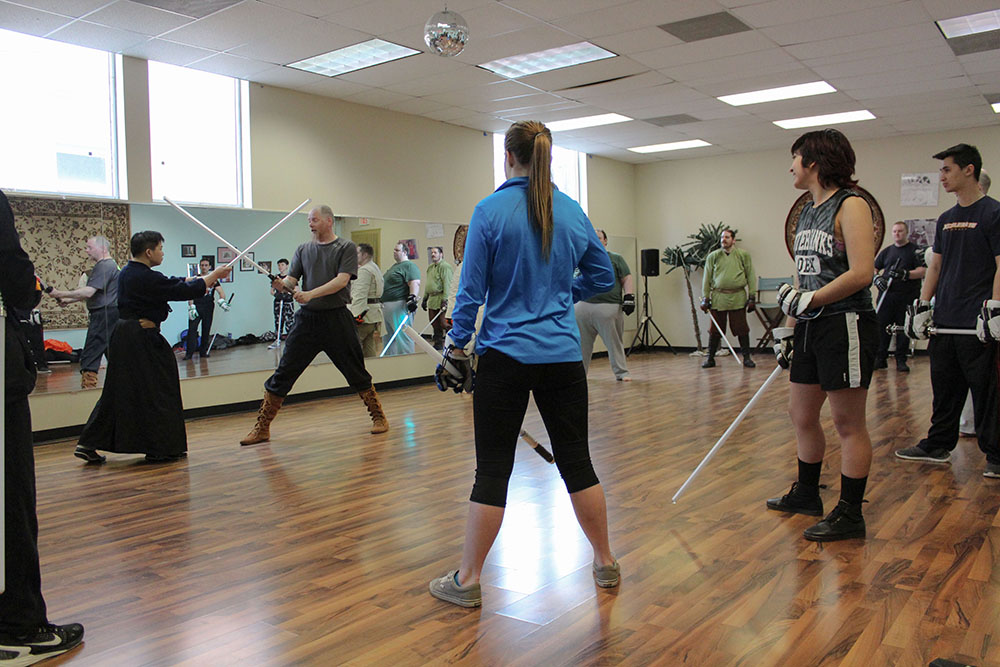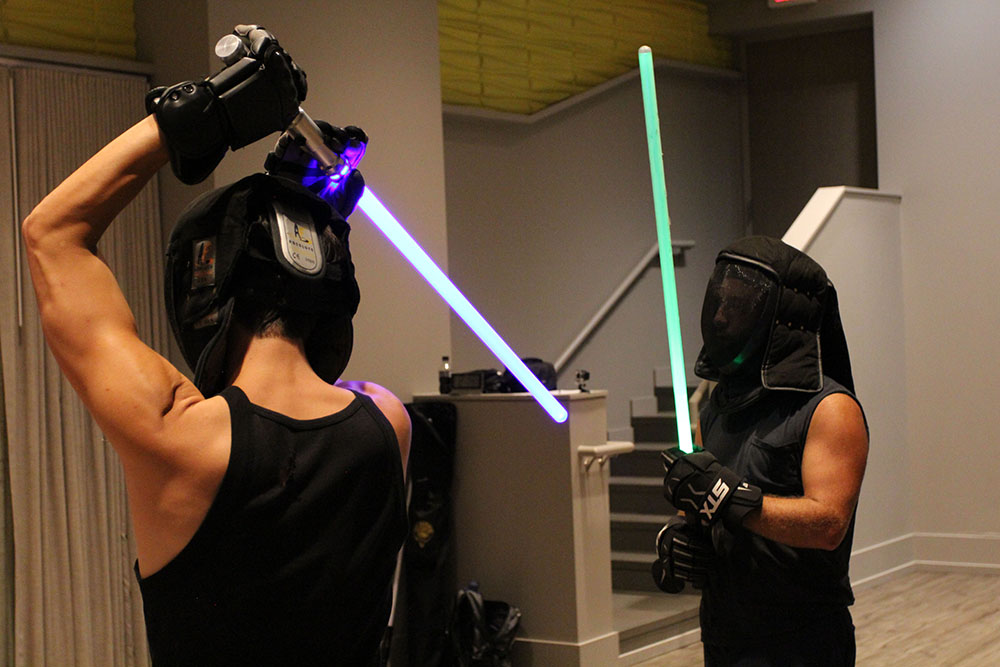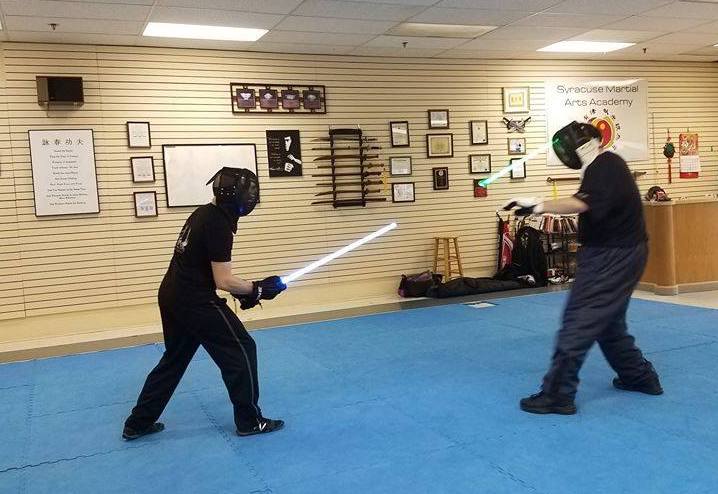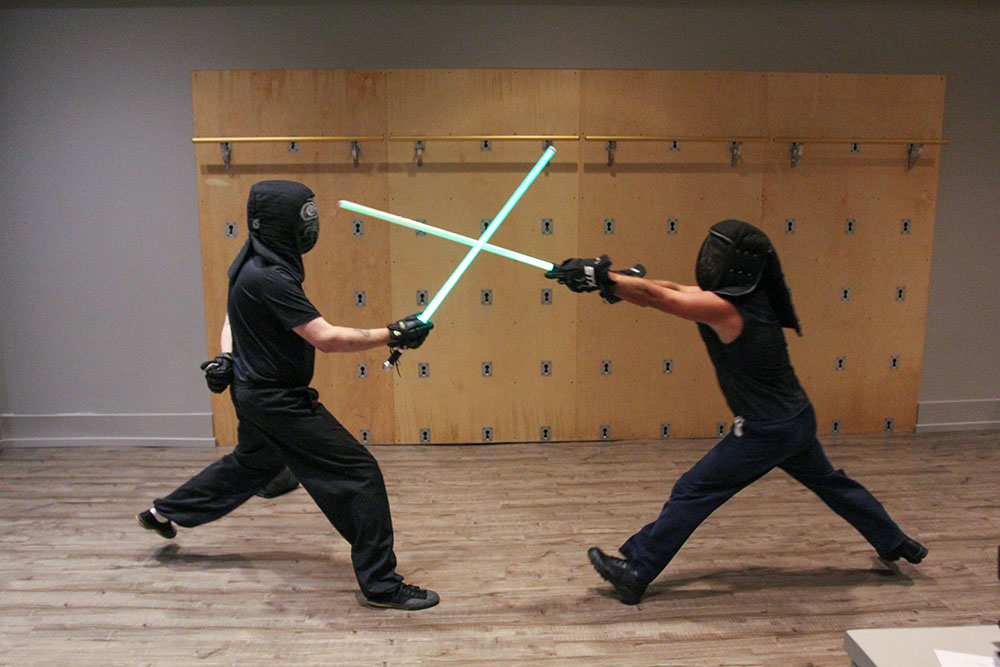Martial artists love their myths, and so do Star Wars fans. After completing a major study of the Southern Chinese martial arts, I recently found myself thinking about the functions that myths, legends and stories play in our experience of the martial arts. Many Kung Fu students in the West are well-versed in the legend of the burning of the Shaolin Temple. But how does a narrative such as this really contribute to our practice of the martial arts? And how do these stories sometimes inspire individuals to do incredible things?
For better or worse, most Kung Fu students seem to accept the historical legends that surround their practice at face value. Practitioners of lightsaber combat have no such luxury. They are acutely aware that their favored weapons do not (and cannot) exist. So how does one’s experience of a martial art change when everyone accepts that the founding stories really are myths? And what can we learn about the martial arts in general by examining the creation of a newly emerging discipline? These are a few of the questions that have driven my research with the lightsaber combat community.

Chad Eisner leads a class of prospective Jedi.
In other articles and book chapters I have dealt with the question of whether (and how) lightsaber combat might be considered a martial art in a purely academic sense. Rather than rehashing that here, I would like to delve a little deeper into the creation of these systems, and what this suggests about the martial arts. The first point may seem obvious, but it is so often overlooked in these discussions that it bears repeating. While we often talk about “martial arts” as a singular social phenomenon, in fact this category encompasses many different practices with distinct (and sometimes contradictory) goals.
This same diversification can be seen within the emerging lightsaber combat community. Some groups have attempted to create a Star Wars based analogue of traditional martial arts schools (including the Terra Prime Light Armory and Silver Sabers). Others have focused on the creation of fast-paced combat sports (the Saber Legion and Ludo Sport are two examples). A wide variety of other organizations, including such pioneers of the movement as NY Jedi (now known as the Rogue Alliance), instead focus on charity work and choreographed public exhibitions.
But why turn to the Star Wars mythos to create something akin to a traditional martial art? Why not go mythos free? We often forget that many of the traditional arts that are most commonly practiced today date only to the end of the 19th or early 20th centuries, largely qualifying as “invented traditions.” It was the growing engagement with the global economic system and increased nationalism in the face of Western imperialism that inspired reformers in Japan and China to radically reformulate local fighting traditions in attempts to solve what were then very modern social and political problems. The traditional Asian martial arts did not emerge in a vacuum.
Likewise, pioneers in the field of lightsaber combat have pointed to the emergence of not just a rejuvenated film franchise, but also a new set of needs, in the creation of their systems. Multiple individuals have noted that by the early 2000s a wide variety of weapons-based training systems were becoming popular. Yet each of these styles remained inured within its national, ideological or disciplinary boundaries. There were not many opportunities for cross training or inter-disciplinary research. Chad Eisner, the creator of the Terra Prime Light Armory, noted:
“When Matt and I started TPLA, it had grown out of our desire to be able to spar with weapons across disciplines. He was in HEMA and I was in Chinese martial arts. We discovered the lightsaber and found it to be the perfect analog to allow people of different backgrounds to set aside styles and focus on the practical, fun, and historical weapon arts we all love. It allowed us to interact with people from vastly different backgrounds and arts. And that was always the goal. I have been heavily influenced by Republican-era Chinese martial arts movements like Jingwu and the Guoshu Institute. The idea was to bring together many different arts to share knowledge and technique, creating a shared curriculum, and using martial practice as a means to better fitness and health. These very important aspects of the Republican period organizations are things that were imparted to me by my study of Yang Taijiquan and Ma Family Tong Bei Fanziquan."

This quote suggests something interesting about just how pervasive the historical influences of the early 20th century reforms within the Chinese martial arts have been. Still the question remains, why is lightsaber combat continuing to grow well into its second decade? And how might the decision to embrace Star Wars’ mythology of Force-wielding Jedi and Sith warrior monks contribute to this success?
At the most basic level a good story can be entertaining and inspiring. Most of us begin our martial arts training because we want to be part of something and improve ourselves. Myths speak to these basic impulses, and play a critical role in the organization of new communities. In the creation of lightsaber combat, the Star Wars mythos provided a rationale for engaging with, and combining, large numbers of diverse real world martial arts techniques. Eisner states:
“When I began my preliminary research on the ideas and lightsaber terminology that was already out there, I came upon the Expanded Universe concept of the “Seven Forms.” They were essentially plot devices used to transmit character traits in a novel way within a story or video game. As such they were fairly crude, simple, and often diverged from reality considerably (as one would expect). To bring them all together into a workable whole, or at least a unified framework, I relied on my Chinese weapon training, taking exercises and forms from Wudang jian, Shaolin dao, and several other styles that would form a firm technical base for many of the ideas and images being communicated through the films and other Star Wars stories.”

Benjamin Judkins (right) sparring with his Lightsaber Combat instructor, Anthony Iglesias at a TPLA school in New York State.
Japanese Kendo, European Fencing and the Filipino Martial Arts all ended up making their own contributions as well. The intellectual and physical challenge of synthesizing existing real world material into a new system seems to have been a major motivation behind the creation of various approaches to lightsaber combat.
Such lofty goals notwithstanding, many students continue to be drawn to these classes simply because they look fun. Nor are they mistaken. That is important as what social scientists call “creative play” is a vital mechanism by which individuals familiarize themselves with, and then master, new skills. Whereas many traditional martial arts classes go out of their way to emphasize their dedication to core social ideals (whether they come in the form of discipline, nationalism, or old fashioned “hard work”), lightsaber classes, unsurprisingly, tend to be less rigid. This is often a space where individuals who are already martial artists come to “have fun” with friends from different styles.
Still, in lightsaber combat as in life, there is no progress without discipline, practice and some amount of “hard work.” Nor are the basic skills of the styles any less complex because they are performed while holding a replica lightsaber rather than a replica dao. As with any martial art, daily practice remains the key to mastery. This is where the mythos of the Jedi (and Sith) once again enters our story. These symbols and stories provide the necessary inspiration for individuals to dedicate themselves to a demanding discipline, while continuing to engage in the sort of imaginative play that is often missing from modern life. In describing this process Eisner notes:
"Star Wars as envisioned by Lucas was a way to bring Joseph Campbell’s myth making ideas to the masses. The commercial success of Star Wars shows that we, as people, need stories to help us find meaning in things we do. The background lightsaber material we use contains a strong, internally consistent, mythological discourse. While this tends to be seen as completely superfluous in “historically grounded” martial arts, it becomes an important factor if someone is going to suspend their disbelief in a new practice. By self-consciously creating arts that can exist entirely in a fictional world, the practitioner can more completely immerse themselves in their practice without distraction.

Chad Eisner (left) sparring with one of his students.
"When people are immersed, they tend to practice longer often without realizing it. We all need to play. Even in traditional martial arts and sports, we play at combat. We are not really trying to hurt each other. But being able to feel like this is real, even when it is not, is a powerful feeling. It inspires us to keep going. And that depends on not only a history, but a mythology that our personal experiences can be measured against. Even if it is not real.”
At its best mythology does not trap us within a set of misconceptions about the past, but it reminds us of what we aspire to be. We tell stories about the burning of the Shaolin Temple not because we actually have an obligation to pass along to our students an inherited grudge against China’s Manchu ethnic minority. Rather, we continue to tell the story because it inspires us to persevere in our training even in the face of isolation and adversity. That lesson is just as critical for traditional martial artists today as it has ever been in the past. The transformative power of myth lies in its ability to inspire empathy, individual effort and the creation of communities. The success of lightsaber combat, in its many incarnations, reminds us of this. It is no wonder that so many martial artists today are drawing inspiration not just from the burning of Shaolin, but the destruction of the Jedi Temple as well. Myths do work, and sometimes what we all need is a good story.
About
Dr. Benjamin N. Judkins and Chad Eisner :
![]() Benjamin N. Judkins has a PhD in Political Science from Columbia University and is currently a Visiting Scholar at Cornell University’s East Asia Program. He is a founding co-editor of the interdisciplinary scholarly journal Martial Art Studies and with Jon Nielson co-authored The Creation of Wing Chun: A Social History of the Southern Chinese Martial Arts (SUNY Press 2015). He also writes and edits the martial arts studies themed blog Kung Fu Tea.
Benjamin N. Judkins has a PhD in Political Science from Columbia University and is currently a Visiting Scholar at Cornell University’s East Asia Program. He is a founding co-editor of the interdisciplinary scholarly journal Martial Art Studies and with Jon Nielson co-authored The Creation of Wing Chun: A Social History of the Southern Chinese Martial Arts (SUNY Press 2015). He also writes and edits the martial arts studies themed blog Kung Fu Tea.
Chad Eisner learned Yang Shi Taiji and WuDang Jian from Gabriel Chin and currently studies Ma Shi TongBei under Master Ma Yue. In 2012 he founded Terra Prime Light Armory as a way for different weapon traditions to be able to spar and play together without limitations of style. He teaches and hosts workshops in Ann Arbor, Michigan.
![]() Print Friendly Version of This Article
Print Friendly Version of This Article














